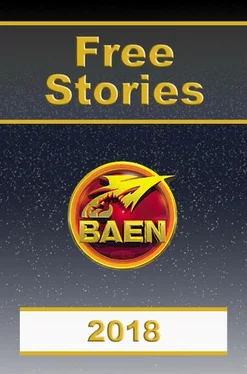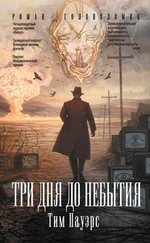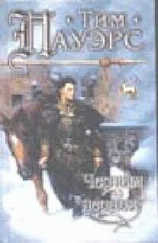“Perhaps it’s Yoder’s device,” Willett speculated.
“But how could anything that small be producing this field?” demanded Takeda. “Especially after all this time? You told me Yoder came out here a generation ago.”
“The effect must be largely self-sustaining, with minimal assistance from the generator. Perhaps the two-way gravitational action somehow produces energy in a manner analogous to the ‘tidal heating’ observed on many moons of massive planets.” Willett shook his head, dismissing the subject pending further observation. “Captain, are we going to get any closer to it?”
Takeda glanced at the nav plot. “Yes, we’re not quite at perigee yet. Soon we’ll—”
At that moment, a series of threat displays awoke, and a new icon appeared on the nav plot astern of them, about sixty degrees clockwise and moving rapidly out from the center of the vortex.
“Captain—” Malone began.
“I see it, Number One. Beat to quarters. And give me an ID of that ship as soon as you can get some sensor readings on it.”
As the alarms whooped through the ship, the artificial gravity field took hold of the mysterious newcomer while it was still within the Primary Limit and began to bend its course into a counterclockwise orbit that would more or less follow Hawke ’s.
“Where did it come from?” demanded Willett, staring wide-eyed at the icon that had sprung so inexplicably into being.
“I was hoping you’d be able to give me some help with that, Doctor.” Takeda ordered himself to keep his voice level.
“Captain,” Malone called out, “the sensor readings are in, and the computer has run them against our database. They don’t exactly match any known ship.”
“Go for similarities, then.” Takeda swung toward the communications officer. “Mr. Chandra, raise that ship.”
“I can’t sir,” Lieutenant Chandra reported. “Whatever this exotic energy field is, it’s creating a lot of interference.”
“Well, keep trying. Any luck, Number One?”
“Yes, sir.” Malone’s voice was crisp and emotionless. “The closest match is the big Gharnakh warship that we have data on. But that one was equivalent to one of our fourth raters. This one is somewhat more massive and has a stronger energy signature.”
So it’s almost equivalent to one of our capital ships … “Mr. Davison,” Takeda snapped at the helmsman, “get us out to the Secondary Limit!”
Had they already been outside the Secondary Limit, Hawke could simply have ducked into the safety of its warp field. As it was, Davison thought a command into the neural-induction helmet that mind-linked him with the ship’s brain, and Hawke surged under sublight pseudo-acceleration. But at appreciably the same instant, the Gharnakh ship passed the Primary Limit and proceeded to do exactly the same thing. And it immediately became apparent that the Gharnakh’sha could pull at least as many Gs as they could… in fact, a few more.
“Captain—” a bewildered Willett began. Takeda shushed him with a peremptory gesture and thought furiously. As a fifth rater, Hawke was armed primarily with laser weapons. Her reaction-drive missiles were useful against planetary targets or immobile orbital installations, but their puny few Gs of acceleration made them laughable in a deep-space engagement against ships with Bernheim Drives. He allowed himself to hope the same would be true of the Gharnakh ship, which after all wasn’t quite of capital-ship size…
The hope died aborning as tiny red icons began separating from the large red one in the tactical plot. “Torpedoes,” said Malone in a flat voice.
“So I see,” said Takeda. “Torpedo” was a term of art for big missiles with overpowered Bernheim Drives of their own. In human space navies, only capital ships carried them. Evidently the Gharnakh’sha had slightly different ideas. He told himself that the ship he was up against couldn’t possibly mount many of the things. But four of them were streaking toward Hawke at what the computer said was almost nine hundred Gs. “Mr. Nichols, get a target lock on those torpedoes and fire at will as soon as they come within range.”
“Aye, aye, sir,” the weapons officer acknowledged. From all the turrets that could be brought to bear, gigawatt X-ray lasers stabbed invisibly out across space. They were longer-ranged than the savage bomb-pumped X-ray lasers the torpedoes would generate when they detonated, which provided a window of opportunity for destroying them—not a wide enough window to suit Takeda.
Still, Nichols accounted for one of them promptly, and the icon of another began to flicker as its force shields overloaded. Takeda looked back at the nav plot. Even at their prodigious pseudo-accelerations, Hawke and her pursuer were both struggling out of the gravity well.
“Number One, run a computer projection. Are we going to reach the Secondary Limit before the Gharnakh’sha catches us?”
“I just did, sir.”
“And the answer?”
“Almost.”
“I see. Thank you.” Takeda decided not to tell Willett what that meant. In what passed for a face-to-face duel in space warfare, Hawke wouldn’t stand a chance. He would try to close the distance even more so he could use his fusion guns—short-range ship smashers. But that wouldn’t save them. The Gharnakh ship undoubtedly mounted similar weapons; and even though the aliens’ versions were believed to be less powerful, a ship that size would have a lot more of them.
Maybe I’ll tell Willett after all. He has a right to know.
He was opening his mouth to speak when a new icon in the nav plot caught his eye.
This one, too, appeared out of nowhere, coming out from the center of the vortex, but it was only about thirty degrees astern of them. Thus, when the gravity field took hold and began to bend its course into a counterclockwise orbit, that projected orbit brought it between the Gharnakh’sha and Hawke .
Takeda became aware that Malone was looking over his shoulder. “Another Gharnakh ship, sir?” she asked, unable to keep despair out of her voice.
“Maybe. Run an ID check—” But even as Takeda gave the order, it became superfluous. The Gharnakh ship, as though forgetting Hawke ’s existence, opened fire on the newcomer. That fire was returned, and the readouts jumped at the intensity of the energy being expended. At the same time, two secondary icons separated from that of the unidentified ship.
“Torpedoes?” Takeda demanded of the sensor officer.
“No, sir. They’re too big for that. More like manned spacecraft.”
“I see.” Neither the Royal Space Navy or any other known service favored the concept of fighters, or light assault craft. Evidently, somebody did.
“Captain,” Malone called out, “the ID check is completed. There is nothing in our database even remotely similar to this new ship. It’s a complete unknown.”
“Well, we know one thing about it: its doing us a bloody good turn by fighting the Gharnakh’sha.” Takeda reached a decision. “Mr. Davidson, reverse our acceleration and kill as much of our velocity as you can. We’re going to join this battle—or, rather let it catch up with us.”
“Aye, aye, sir.”
The closing of the range enabled one of the Gharnakh torpedoes to detonate before they could destroy it, but their force shields held the damage to acceptable levels. In the meantime, the secondary craft launched by the Gharnakh ship’s new nemesis went in like dogs attacking a bear. One of them was vaporized and the other reeled away, clearly disintegrating; but they had inflicted damage, and had drawn off enough Gharnakh fire to allow their mother ship to inflict still more, even though the greater firepower of its larger enemy was clearly wearing it down.
Читать дальше








![Тим Пауэрс - Последние дни. Том 2 [litres]](/books/393813/tim-pauers-poslednie-dni-tom-2-litres-thumb.webp)
![Тим Пауэрс - Последние дни. Том 1 [litres]](/books/394090/tim-pauers-poslednie-dni-tom-1-litres-thumb.webp)
![Тим Пауэрс - Последний выдох [litres]](/books/402145/tim-pauers-poslednij-vydoh-litres-thumb.webp)